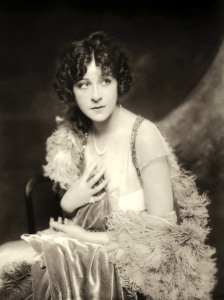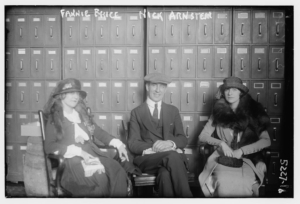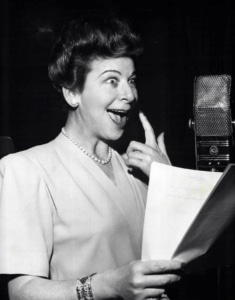DCPA NEWS CENTER
Enjoy the best stories and perspectives from the theatre world today.
Enjoy the best stories and perspectives from the theatre world today.
When imagining the iconic Funny Girl star, wearing a long red coat and black feathered hat, belting out “Don’t Rain On My Parade,” you likely envision Barbra Streisand who originated the role of Fanny Brice on Broadway in 1964 as well as the 1968 film version.
There is a perception of Fanny Brice based on the famous musical; a rags-to-riches story of a woman entangled with a no-good husband while fighting for her stage career and the fame she deserves. This is largely associated with Streisand, who not only has Funny Girl to thank for her skyrocket to fame, but who also won the Academy Award for Best Actress in the film adaptation.

Fanny Brice
Many don’t realize Brice was a real person, nationally recognized in the early 1900s. Or, for those who are aware there was a real “funny girl,” it may not be known that Funny Girl is a highly fictionalized account of Brice’s life.
Her life was fascinating and turbulent, which is why she serves as excellent inspiration to the musical. But if you’re interested in the real story, Brice has her own version to tell.
In 1910, Florenz Ziegfeld, an American theatrical producer, heard a young Fanny Brice sing in a burlesque show. Ziegfeld was the creator of the Follies revue, modeled on the French Folies-Bergère (but less risqué). Women wearing elaborate costumes performed songs and dances; something between a modern Broadway show and a vaudeville act. Ziegfeld recruited Brice to join the show.
Brice was a headline act for the Follies for several years due to her widespread popularity. In the 1921 Follies, she was featured singing “My Man,” which became both a big hit and her signature song. Brice was awarded a posthumous Grammy Hall of Fame Award for her 1921 recording of the song in 1999.
Though she was a talented singer and performer, Brice became widely known for her comic routines. When the Great Depression took a toll on stage performances, many actors took to the radio, including Brice. From the 1930s until her death in 1951, Brice performed as a character called Baby Snooks, modeled after a bratty toddler, across several radio networks, eventually landing her own show.

Fanny Brice (left) and Nicky Arnstein (center). Photo courtesy Library of Congress
While Brice’s fame continued to rise, reaching its height before her untimely death, her personal life was tumultuous – as hinted at in the Broadway musical. However, there are several stark differences between real life and the adaptation.
First, Brice was briefly married prior to her romance with Nicky Arnstein – a fact that isn’t mentioned in the musical at all. As a teenager, Brice was married to a barber named Frank White from 1910 to 1913.
Her second husband was Nicky Arnstein, professional gambler and conman. Contrary to aspects of the musical adaptation, Brice was fully aware of Arnstein’s criminal tendencies. The couple lived together for three years before Arnstein was convicted of a wiretapping swindle in 1915. Brice visited him at Sing Sing every week for the 14 months he served of his prison sentence, before Brice secured him a pardon.
All this time, Arnstein was married to another woman named Carrie Greenthal. In 1918, Greenthal sued Brice for alienation of Arnstein’s affection and subsequently divorced Arnstein. Brice and Arnstein immediately married once the divorce was finalized.

Fanny Brice voicing Baby Snooks, 1950
Unfortunately, their romance was anything but idealistic. In 1920, Arnstein was charged with conspiracy to sell $5 million of stolen Wall Street bonds. Eventually, he was sentenced to two years in a federal penitentiary and was released in 1925.
In the Funny Girl musical, Arnstein is resentful of Brice’s success, refusing to play second fiddle to her fame. In real life, Arnstein abused his connection to Brice’s money, draining her savings accounts to fund his legal defense.
The couple reunited after Arnstein’s release, but ultimately divorced in 1927 on grounds of infidelity, when Brice discovered Arnstein’s affair with an older, wealthy woman.
After the divorce, Brice’s fame continued to grow. She remarried in 1929 to Billy Rose, a producer. Brice starred in his revue Crazy Quilt and a few films. Her film career culminated in an appearance in Vicente Minnelli’s 1945 musical comedy, Zigfield Follies, starring Judy Garland and Lucille Ball.
She continued as Baby Snooks with her own radio show through 1951. On May 29, 1951, Brice died from a cerebral hemorrhage at only 59 years old. The Baby Snooks Show was due to air that evening, but a memorial broadcast aired instead. Brice was honored with a musical tribute and brief eulogy.
Read Fanny Brice: The Original Funny Girl by Herbert Goldman to learn more about the real woman and her captivating story. Then, see Funny Girl on the Buell stage to witness the differences between reality and fiction.
DETAILS
Funny Girl
Dec 10 – 22, 2024 · Buell Theatre
Tickets
